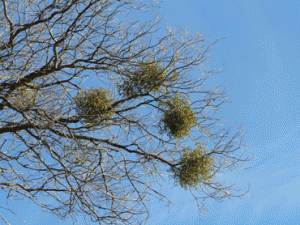Why The Holidays Are Green
 by Ray Novitske, Fairfax Master Gardener
by Ray Novitske, Fairfax Master Gardener
Before green plastic decorations became popular, many people brought live greenery into their homes to celebrate the holidays. It freshened indoor air during winter months when people were shut in and often in close proximity to one another. But further back in time, bringing outdoor greenery in served other purposes, as well.
Some people believed evergreens had magical powers because they stayed green while other plants died in the winter. They believed the branches and vines of these perpetually green plants contained life and vigor and would ward off evil spirits present in howling winds and long, dark winter nights. In addition, they thought the greenery would keep away witches, ghosts, illness and death.
Decorating with greenery in December helped remind our ancestors of the coming spring and the return to life. In Europe, Druids adorned their temples with evergreen boughs in winter as a symbol of everlasting life. During the winter solstice, Egyptians decorated with palms as a tribute to the sun god, Ra. The palms symbolized a stronger sun, as well as the return of spring, agriculture and green plants — the triumph of life over death.
Christmas trees
The tradition of bringing pine trees indoors for Christmas, many believe, began in Germany. Legend has it that Martin Luther was wonderstruck by evergreens sparkling in starlight. He recreated the scene for his family by hauling an evergreen tree indoors and lighting it with candles. Later, others adopted the idea, decorating the trees with tinsel, cookies and strings of fruits and nuts.

Queen Victoria’s Christmas Tree in the 1846 London Times
In the United States, Christmas trees did not catch on until the mid-1800s; in fact, before then, Christmas was not celebrated as a major holiday. That changed, however, as the country grew more urban and industrialized, and Christians sought to satisfy a desire for nostalgia. Celebrating Christmas brought families closer together — something Civil War soldiers especially craved.
Some Germans emigrating to the U.S. in the 1830s brought the indoor Christmas tree tradition with them, while Americans visiting Germany fell in love with the idea of indoor evergreen trees for the holiday. The custom spread in England after a picture was published in 1846 of Queen Victoria’s family, including her German-born husband, gathered around an evergreen Christmas tree. In turn, fashionable New Englanders, seeking to imitate Europe, embraced the tradition.
Fresh cut trees last best if put into plain water with no bleach, aspirin, sugar, or other additives. Additions to the water do nothing according to the National Christmas Tree Association. Cutting off only one inch of the trunk is needed – no more. “Hot tap water in the tree stand increases water uptake in some trees.” Visit the NCTA web site to find a tree species that has the characteristics you desire.
Poinsettia
As early as the 14th century, Aztecs cultivated poinsettias, a native of Mexico and Central America, for use in dyes. Dr. Joel Poinsett, the first U.S. ambassador to Mexico, brought the plant to the United States in 1828. The red and green poinsettias, blooming in December, became the perfect plant to symbolize Christmas.
To get your poinsettia to rebloom from the previous year, give the plant continuous complete darkness for at least 14 hours each night beginning in early October. Poinsettia are photoperiodic plants that set their buds as nights lengthen in the fall. The plant blooms around December, but its flowers are not really flowers but colored leaves. The real flowers are actually quite small.
Holly & Ivy
 To honor Saturn, the god of agriculture, Romans decorated with ivy at the feasts of the winter solstice. Merrymakers would wear wreaths of ivy on their heads during these celebrations. The holiday was meant to welcome the lengthening days and the eventual return of Saturn, light, spring and the growing season. Later, holly and ivy were intertwined in customs of the Middle Ages. Holly represented the male and ivy represented the female in traditional art, rituals, and culture.
To honor Saturn, the god of agriculture, Romans decorated with ivy at the feasts of the winter solstice. Merrymakers would wear wreaths of ivy on their heads during these celebrations. The holiday was meant to welcome the lengthening days and the eventual return of Saturn, light, spring and the growing season. Later, holly and ivy were intertwined in customs of the Middle Ages. Holly represented the male and ivy represented the female in traditional art, rituals, and culture.
The Christian Church promoted evergreen holly as a substitute for ivy during Christmas. Ivy, after all, grew in shade and was thus looked upon with suspicion. Holly leaves, however, could symbolize Christ’s thorny crown, while the red berries suggested drops of blood.
Mistletoe

Mistletoe
In Norse mythology, enemies who met under mistletoe had to lay down their weapons and declare a truce. The son of the Norse god, Frigga (who represented love and beauty), was killed by an arrow made from mistletoe. Frigga’s tears — the white berries on mistletoe — revived her son. She then promised that mistletoe would no longer kill but would be used to encourage love. To kiss anyone who passed beneath mistletoe was to fulfill this pledge.
So as we hang the green boughs — plastic or real — from our mantles this year, let’s give a nod to the people who first gave us the idea.
References
Reblooming Poinsettias, University of Illinois Extension
The Poinsettia Page: History & Legends, University of Illinois Extension
Frequently Asked Questions, National Christmas Tree Association
The History of Holiday Greens, University of Vermont Extension
What Does Mistletoe Have To Do With Christmas?, American Phytopathological Society
Green Christmas: The History and Legends of Holiday Plants, The Social Silo
The History of Holly & Ivy, Altogether Christmas